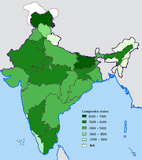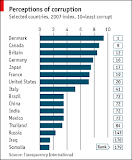There are several instances of violent crime against foreigners in India.[50] Many of the crimes occur against foreigners only. Scams involving export of jewels occur in India, which target foreign citizens.[50]
Political demonstrations are common in India and frequently turn violent. Transportation and services are often disrupted. Traveling alone in remote areas after dark is of particular risk to foreigners.[51]
Because U.S. citizens' purchasing power is relatively large compared to the general Indian population, they the preferred target for robbery and other serious crime.[52]
In April 1999, Swaraj Damree, a tourist from Mauritius was befriended by a group of Indians who later held him in 25 days of captivity. They robbed him of cash amounting to US $1,500, took his travellers' cheques, wrist watch, gold chain, bracelet, two bags and suitcase.[53] In 2000, two German trekkers were shot in Himachal Pradesh. A few weeks later, two Spanish tourists were killed in Himachal Pradesh by robbers.[54] Many foreign tourists are victims of violent crime in Kolkata.[55] In September 2006, criminals robbed the wallet of a British woman in Kolkata.[55] The same month, a Japanese tourist was robbed on his way to Sudder Street.[55] In October 2006, a foreigner was robbed in daylight on Park Street.[55]
Petty crime
Petty crime, like pickpocketing, bag snatching etc. are widespread in India. Theft of valuables of foreigners from luggage on trains and buses is common. Travelers who are not in groups become easy victims of pickpockets and purse snatchers. Purse snatchers work in crowded areas.[56]
Passport theft
In India, stealing passports of foreigners from their luggage on trains and buses is widespread.[50] Theft of U.S. passports is very common, especially in major tourist areas.[52][57]
Scam incidents
Many scams are perpetrated against foreign travelers, especially in Jaipur, the capital of Rajasthan.[52] Scams usually target younger foreign tourists and suggest them that money can be made by privately transporting gems or gold or by taking delivery abroad of expensive carpets avoiding customs duties.[52]
Such incidents pull the traveler over the course of several days and begin with a new scam artist who offers to show the foreign traveler the sights. They also offer cheap lodgings and meals to foreign travellers so that they can place the traveler in the physical custody of the scam artist and can leave the foreigner with threats and physical coercion. In the due process, the foreigner lose his passport.[52]
In 2006, an American became victim of a scam at Chhatrapati Shivaji International Airport in Mumbai, by which she lost US $77.[58]
Taxi scam
There are also taxi scams present in India, whereby a foreign traveler, who is not aware of the locations around Indian airports, is taken for a ride round the whole airport and charged for full-fare taxi ride while the terminal is only few hundred yards away.[56] Overseas Security Advisory Council in a report mentioned the process about how to avoid taxi-scam.[56]








